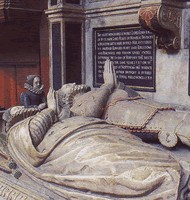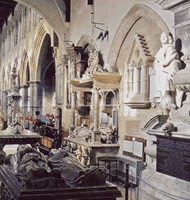


The Church of St. Mary the Virgin, often called "The Lady of the Vale," is one of the largest village churches in England. Situated at the northeast of the village, a Grade I listed church built mainly of limestone (with some ironstone in the chancel) and within a conservation area, the church stands imposingly by a ford over the River Devon, the churchyard being bordered on three sides by a loop in the river. The well-kept churchyard has many notable gravestones, the earliest dates from 1689, the remaining reflect the changing styles and fashions through to the present day. Some bear the Belvoir Angel motif, local to the Vale of Belvoir and Framland, dating from the late 1600s and first part of the 18th century.
The most attractive approach to the church is over Fleming's Bridge and along an old York stone path to the south porch entrance. Dominating this approach is the tower and spire, dated about 1420. Uniquely the spire is 36 feet taller than the tower on which it sits, but so skilfully designed it is in perfect proportion; overall the tower and spire reach a height of 210 feet. Of note are the richly carved gargoyles which decorate the outside, some of which can only be seen when standing at a distance from the church.
In plan, the church consists of a chancel with a late medieval vestry on the north side; north and south transepts; a nave with north and south aisles, a south porch and at the west end a tower and spire.
The earliest part of the church is found in the lower part of the chancel and dates from the Norman period. The rest of the church took a further three hundred years to build and therefore reflects the changing styles which developed through that period.
The south porch is late Decorated and originally had a parvaise or priest room in the upper half, evidence of which is still clearly seen. The nave is a mix of late Decorated and Perpendicular. The north and south aisles were added about 1350 with a clerestory of eleven three light windows, on both north and south aspects, being added in the 15th century; these once contained coloured glass. The nave, rebuilt in the 14th century, was of six bays of equal width, however, the two eastern pillars are now further apart, are perpendicular and were constructed to facilitate the north and south transepts. The nave was re-roofed circa 1740.
The chancel contains a remarkable collection of tombs of the Lords of Belvoir spanning almost 400 years. These tombs, (two by Grinling Gibbons), are an unrivalled series of eight earls - with six Knights of the Garter. Included is the only known tomb in England to record a death, by witchcraft, of two heirs to an earldom. In 1828 a mausoleum was built at Belvoir Castle and all the 18th century bodies were re-interred there. Twenty-four monuments, tablets or stained glass windows commemorate the Belvoir families in Bottesford church. Restoration of the monuments was carried out in 2003.
The chancel is also notable for being the nave to an earlier church, with north and south aisles, dating from the 12th century, although much that is now visible is Early English. The glass in the south west clerestory in the chancel is made up of remnants of glass, some of which could date back to the 13th century. On the north side of the chancel is the fa�ade of the old organ. In 1995 this organ was purchased by the church at Willoughby-on-the Wolds and replaced by a restored T C Lewis 1905 organ, built into the north transept. The Codyngtoun Brass situated in the floor of the chancel is a fine example commemorating Henry de Codyngtoun, Rector of Bottesford who died in 1404.
Following the appointment of Canon Norman as rector in 1846 a major restoration of the inside of the church commenced and continued throughout the Victorian period. In 1863 major underpinning work to the tower was required. Cracks had appeared in the west front of the tower and it was considered that the tower could collapse at any time.
The tower houses a peal of eight bells; the earliest bell was cast in 1612 the last two in 1903. In 1926 the bell frame was found to be defective. A new frame was constructed and installed sixteen feet lower to lessen the strain on the tower and improve the spread of the sound.
Most of the stained glass windows are Victorian, although some are earlier, one (in the south transept), commonly known as the 'Musicians Window' it is dedicated to Janetta Duchess of Rutland who died in 1899 and is the work of C E Kempe.
Above the entrance arch to the east end of the nave are the arms of Queen Victoria, probably erected to commemorate her accession, but the queen may have attended the church as she is known to have visited Belvoir Castle. Above these arms are the remains of a medieval wall 'Doom' painting; although portions can be seen the plaster has so deteriorated that much has faded or is lost completely.
Of note in the nave are the Jacobean carved oak pulpit of 1631; the magnificent brass eagle lectern (presented by the ladies of the parish in1873) and the accompanying podium (presented by Rector Jackson in 1907). The font at the west end of the nave is an octagonal 15th century bowl perched on a Renaissance base. The animal carvings above the nave pillars may portray the weakness of human nature, the Seven Deadly Sins!
In the south transept is a Saxon Font found and rescued from a local garden by a former verger.
In the south west corner of the south aisle, is the much weathered recumbent figure of the 'Fair Maid of Normanton'. Legend has it that she was a 'flighty' member of the Belvoir household and because of this the effigy lay in the churchyard until 1905. The headdress shows the date of the effigy to be about 1380. In the north aisle are four funeral hatchments which were moved there when the chancel we re-roof in 1968.
Just to the east of the south door entrance is the war memorial commemorating the dead of the two world wars. Moving into the Lady Chapel there is a wall plaque, (with accompanying Roll of Honour) commemorating the dead of 207 squadron which was based at the RAF Bottesford during the WWII. In the north transept is a wall plaque recognising the life of Bishop Thomas White of Peterborough, Rector of Bottesford 1678-1685, who was one of the seven bishops committed to the tower in 1688 for petitioning against the reading in all churches an order issued by King James II the "Declaration of Indulgence"